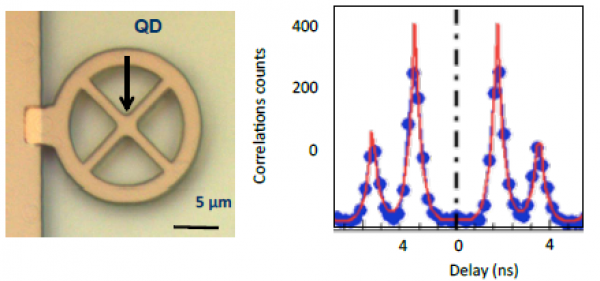
Left: microscope image of the connected pillar device.
Right: HOM measurement under
resonant excitation/ the absence
of the zero delay peak shows an
indistinguishability of 0.998.
The goal of the ICQOQS project is to consolidate the research efforts developed within the LabEx NanoSaclay in the fields of integrated quantum optics, nanophotonic and quantum simulation. Teams involved in the consortium gather unique expertise to meet the challenges in that domain: ultimate nanocavities and plasmonics structures, bright solid state single photon sources, polaritonic networks, few photon optical non linearities, single spin manipulation… Beyond exploring new ideas within each system, the project will combine existing technologies to create innovative devices and propose new paradigms for linear optical quantum computing and quantum simulation on chip.
We plan to conduct two main research lines. The first relies on single emitters and single spins to implement quantum functionalities. The second one aims at quantum light manipulation and simulation on chip.
The first research line makes use of two level systems (atoms or artificial atoms) coupled to optical nanostructures to implement quantum functionalities: efficient generation of flying quantum bits in the form of single photons, coherent control of stationary quantum bit and spin based quantum memories, development of efficient interfaces between stationary and flying quantum bits, demonstration of deterministic quantum optical gates. Phonon induced dephasing mechanisms, that are known to be a limitation to coherent control in artificial atom systems, will be investigated in the vicinity of nanostructures through nanoprobe techniques and phononic devices will be developed to control their coupling to artificial atoms.
The second research line is devoted to the development of on chip quantum functionalities such as quantum logic gates, quantum random walks and quantum simulation. A new approach based on coupled waveguides arrays, will be explored to bring new paradigms in the generation, routing and manipulation of path entanglement. First probed with coherent states of light or heralded single photon sources, these photonic circuits will then be operated with the bright single photon sources developed in the first research line. Taking advantage of strong optical non-linearities obtained in polariton systems or in ultra-small coupled cavities, optical gates and photon blockade phenomena will be explored. Finally, physical problems that cannot be simulated with classical computers will be emulated using strongly interacting polaritons or waveguide arrays in a large variety of photonic structures.
Contact: Pascale Senellart, LPN




